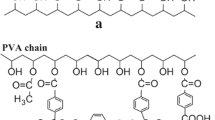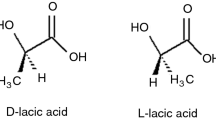Abstract
Two polymers poly[bis(p-Cresol)phosphazenes] (PBPP) and poly[bis(p-cresoldiethyl amino)phosphazenes] (PBPDEAP) were synthesized, characterized and subjected to hydrolytic degradation and investigated in vitro degradation for drug delivery. The syntheses were carried out by thermal ring-opening polymerization followed by chlorine replacement via macromolecular substitution reaction. The polymeric products were characterized by FTIR, 1H NMR, thermal analysis (DSC), elemental analysis and gel permeation chromatography (GPC) analysis. Hydrolytic degradation was observed by percentage weight loss in buffer solutions of a broad pH range (4.5–10) in deionized water at body temperature (37 °C). It was found that PBPDEAP degraded more rapidly than PBPP, and hydrolytic degradation mechanism was proposed. It was found that PBPP and PBPDEAP are biodegradable, biocompatible and non-toxic and can be tailored for in vitro and later in vivo studies.








Similar content being viewed by others
References
Amin, A.M.; Wang, L.; Wang, J.; Yu, H.; Huo, J.; Gao, J.; Xiao, A.: Recent research progress in the synthesis of polyphosphazenes and their applications. Desig. Mono. Polym. 12, 357–375 (2009)
Amin, A.M.; Wang, L.; Wang, J.; Yu, H.; Gao, J.; Li, C.; Huo, J.; Amer, W.A.; Yan, G.; Ma, L.: Recent research progress in the synthesis of polyphosphazenes elastomers and their applications. J. Polym. Plast. Technol. Eng. 49, 1399–1405 (2010)
Krogman, N.R.; Singh, A.; Nair, L.S.; Laurencin, C.T.; Allcock, H.R.: Miscibility of bioerodible polyphosphazene/poly(lactide-co-glycolide). Blends Biomac. 8, 1306–1312 (2007)
Cho, J.-K.; Hong, K.-Y.; Park, J.W.; Yang, H.-K.; Song, S.-C.: Injectable delivery system of 2-methoxyestradiol for breast cancer therapy using biodegradable thermosensitive poly(organophosphazene) hydrogel. J. Drug Target. 19, 270–280 (2011)
Chaubal, M.V.: Polymeric materials for drug delivery applications. Market Report, Techvest LLC (2003)
Eng, N.F.; Garlapati, S.; Gerdts, V.; Potter, A.; Babiuk, L.A.; Mutwiri, G.K.: The potential of polyphosphazenes for delivery of vaccine antigens and immunotherapeutic agents. Curr. Drug Deliv. 7, 13–20 (2010)
Mutwiri, G.; Benjamin, P.; Soita, H.; Townsend, H.; Yost, R.; Roberts, B.; Andrianov, A.K.; Babiuk, L.A.: Poly[di(sodium carboxylatoethylphenoxy)phosphazene] (PCEP) is a potent enhancer of mixed Th1/Th2 immune responses in mice immunized with influenza virus antigens. Vaccine. 25, 1204–1213 (2007)
Le Cam, N.B.; Ronco, J.; Francon, A.; Blondeau, C.; Fanget, B.: Adjuvants for influenza vaccine. Res. Immunol. 149, 19–23 (1998)
Deng, M.; Nair, L.S.; Nukavarapu, S.P.; Jiang, T.; Kanner, W.A.; Li, X.; Kumbar, S.G.; Weikel, A.L.; Krogman, N.R.; Allcock, H.R.; Laurencin, C.T.: Dipeptide-based polyphosphazene and polyester blends for bone tissue engineering. Biomaterials 31, 4898–4908 (2010)
Deng, M.; Nair, L.S.; Nukavarapu, S.P.; Kumbar, S.G.; Jiang, T.; Weikel, A.L.; Krogman, N.R.; Allcock, H.R.; Laurencin, C.T.: In situ porous structures: a unique polymer erosion mechanism in biodegradable dipeptide-based polyphosphazene and polyester blends producing matrices for regenerative engineering. Adv. Funct. Mater. 20, 2794–2806 (2010)
Deng, M.; Kumbar, S.G.; Nair, L.S.; Weikel, A.L.; Allcock, H.R.; Laurencin, C.T.: Biomimetic structures: biological implications of dipeptide-substituted polyphosphazene-polyester blend nanofiber matrices for load-bearing bone regeneration. Adv. Funct. Mater. 21, 2641–2651 (2011)
Akram, M.; Yu, H.; Wang, L.; Khalid, H.; Abbasi, N.M.; Zainul, A.; Chen, Y.; Ren, F.; Saleem, M.: Sustained release of hydrophilic drug from polyphosphazenes/poly (methyl methacrylate) based microspheres and their degradation study. Mater. Sci. Eng., C 58, 169–179 (2016)
Wei, R.R.; Cheng, L.; Zheng, M.; Cheng, R.; Meng, F.H.; Deng, C.; Zhong, Z.Y.: Reduction-responsive disassemblable core-cross-linked micelles based on poly(ethylene glycol)-b-poly(N-2-hydroxypropyl methacrylamide)–lipoic acid conjugates for triggered intracellular anticancer drug release. Biomacromol 13, 2429–2438 (2012)
Chun, C.; Lee, S.M.; Kim, C.W.; Hong, K.Y.; Kim, S.Y.; Yang, H.K.; Song, S.C.: Doxorubicin–polyphosphazene conjugate hydrogels for locally controlled delivery of cancer therapeutics. Biomaterials 30, 4752–4762 (2009)
Shoichet, M.S.: Polymer scaffolds for biomaterials applications. Macromolecules 43, 581–591 (2010)
Laurencin, C.T.; El-Amin, S.F.; Ibim, S.E.; Willoughby, D.A.; Attawia, M.; Allcock, H.R.; Ambrosio, A.A.: A highly porous 3-dimensional polyphosphazene polymer matrix for skeletal tissue regeneration. J. Biomed. Mater. Res. 30, 133–138 (1996)
Langone, F.; Lora, S.; Veronese, F.M.; Caliceti, P.; Parnigotto, P.P.; Valenti, F.; Palma, G.: Peripheral nerve repair using a poly(organo)phosphazene tubular prosthesis. Biomaterials 16, 347–353 (1995)
Veronese, F.M.; Marsilio, F.; Lora, S.; Caliceti, P.; Passi, P.; Orsolini, P.: Polyphosphazene membranes and microspheres in periodontal diseases and implant surgery. Biomaterials 20, 91–98 (1999)
Andrianov, A.K.; Payne, L.G.: Polymeric carriers for oral uptake of microparticulates. Adv. Drug Delivery Rev. 34, 155–170 (1998)
Wyrsta, M.D.; Cogen, A.L.; Deming, T.: A parallel synthetic approach for the analysis of membrane interactive copolypeptides. J. Am. Chem. Soc. 123, 12919–12920 (2001)
Gunatillake, P.A.; Adhikari, R.: Biodegradable synthetic polymers for tissue engineering. Eur. Cells Mater. 5, 1–16 (2003)
Grodzinski-Jagur, : Polymers for tissue engineering, medical devices, and regenerative medicine concise general review of recent studies. J. Polym. Adv. Technol. 17, 395–418 (2006)
Andrianov, A.K.; Payne, L.G.: Protein release from polyphosphazene matrices. Adv. Drug Delivery Rev. 31, 185–196 (1998)
Lakshmi, S.; Katti, D.S.; Laurencin, C.T.: Biodegradable polyphosphazenes for drug delivery applications. Adv. Drug Deliv. Rev. 55, 467–482 (2003)
Akram, M.; Wang, L.; Yu, H.; Amer, W.A.; Khalid, H.; Abbasi, N.M.; Chen, Y.; Saleem, Z.; Tong, M.: Polyphophazenes as anti-cancer drug carriers: from synthesis to application. R. Prog. Polym. Sci. 39, 1987–2009 (2014)
Sarfraz, M., Suleman, M., Tikoo, S.K., Wheler, C., Potter, A.A., Gerdts, V. and Dar, A. Immune responses to in ovo vaccine formulations containing inactivated fowl adenovirus 8b with poly[di(sodium carboxylatoethylphenoxy)]phosphazene (PCEP) and avian beta defensin as adjuvants in chickens Vaccine. 35, 981-986(2017).
Allcock, H.R.: Chemistry and applications of polyphosphazenes. Wiley, Hoboken (2003)
De Jaeger, R.; Gleria, M.: Poly(organophosphazene)s and related compounds: synthesis, properties and applications. Prog. Polym. Sci. 23, 179–276 (1998)
Yildiz, M.; Dulger, B.; Yilmaz, S.: Synthesis, spectral properties, and antimicrobial activity of phosphazene derivatives. Asian J. Chem. 20, 2719–2732 (2008)
Amin, A. M.; Wang, L.; Wang, J.; Yu, H.; Amer, W.A.; Gao, J.; Lei, Z.; Zhao, Y.; Huo, J.; Tai, Y.: Synthesis and characterization of poly[bis (p-oxybenzaldehyde diethylamino) phosphazenes], poly[bis(p-oxybenz aldehyde) phosphazene], poly[bis(di ethylamino)phosphazenes], and their self assembly behaviors. J. Macromol. Sci., Part A: Pure App. Chem. 48, 937–946 (2011).
Amin, A.M.; Wang, L.; Wang, J.; Amer, W.A.; Huo, J.; Yu, H.; Gao, J.: Synthesis and characterization of poly[bis(resorcinol monobenzoate)phospha zenes], poly[bis(resorcinol monobenzoate diethylamino) phosphazene] and their self assembly behaviors. J. Inorg. Organomet. Polym Mater. 21, 283–290 (2011)
Amin, A.M.; Wang, L.; Yu, H.; Amer, W.A.; Gao, J.; Huo, J.; Tai, Y.; Zhang, L.: Synthesis and characterization of poly[bis(ethyl salicylate)phosphazenes], poly[bis(ethyl salicylate diethylamino)phosphazenes] and their hydrolytic degradation. J. Inorg. Organomet. Polym Mater. 22, 196–204 (2012)
Jing, X.; Xiumei, Z.; Liyan, Q.: Polyphosphazene vesicles for co-delivery of doxorubicin and chloroquine with enhanced anticancer efficacy by drug resistance reversal. Int. J. Pharm. 498, 70–81 (2016)
Author information
Authors and Affiliations
Corresponding author
Rights and permissions
About this article
Cite this article
Shahzady, T.G., Khurshid, S., Abid, A. et al. Synthesis, Characterization and Hydrolytic Degradation of p-Cresol-Substituted Polyphosphazenes. Arab J Sci Eng 44, 6445–6451 (2019). https://doi.org/10.1007/s13369-019-03952-1
Received:
Accepted:
Published:
Issue Date:
DOI: https://doi.org/10.1007/s13369-019-03952-1




